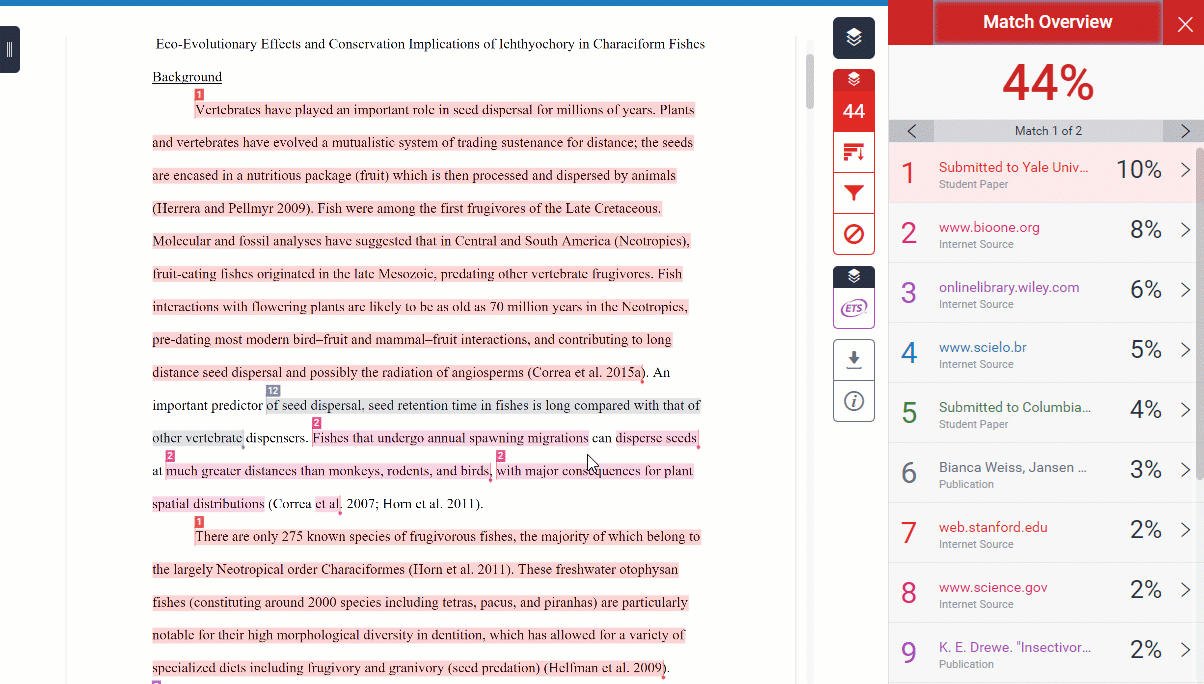Turnitin stores papers submitted at Yale in an institutional (Yale-only) repository. When generating a similarity report, Turnitin checks each Yale student paper against this body of past work and flags passages with a high degree of similarity.
Because Turnitin labels all matches to other Yale papers as “Submitted to Yale University,” you’ll need to determine whether the paper that matches your student’s was submitted in your class or another class at Yale. To do this:
- Click on the number above the highlighted text. (You can also click the source in the right sidebar.)
- In the pop-up window, click the “full source view” icon to display the source side-by-side with the student paper.
- Scroll to the top of the source paper to look for the author’s name, the course it was submitted to, and the submission date.
- Scroll to the top of your student’s paper and compare the name, course, and submission date with those of the source text.
In the example below, the papers were written by different students (Jonathan Edwards and Ezra Stiles) for different courses (FISH 202 and FISH 303) and submitted a few years apart. This suggests that the writer of the paper copied material from a paper written by a student in another course.

To figure out your course of action, you first need to confirm that collaboration occurred. If the flagged passages are long, that is pretty good evidence that your student copied material a peer wrote for a different class. If the copied passage is shorter, it’s possible the two students both read the same source and failed to paraphrase it effectively. To check, follow the process for excluding a source matched to a student at another university.
How to Respond to Your Student
If you’ve determined that your student copied material from a student in a different Yale course, your response should address the issue directly: “Parts of your paper are highly similar to passages in a paper submitted in Course X. I expect all students in this course to do their own work, and failing to do so is a violation of Yale College policy.”
What You can Do in Class
All students will know that copying material from a student in a different course is plagiarism. It isn’t caused by confusion about academic conventions. When a student is working on an assignment they feel is beyond their skill, they’re more likely to seek the help of peers who have completed similar work successfully. The stress of a fast-approaching deadline creates the conditions where permissible collaboration crosses over into copying from a more expert peer.
To create conditions that encourage students to do their own work:
- Change your assignments each term. This requires a little more work on your part, but it reduces opportunities for students to copy from students who have taken your course in previous semesters. Put differently, it will allow your students to seek help from students who have taken your course in the past while limiting their possibilities for copying your former students’ work.
- Assign your students clear, specific writing prompts. Open or general prompts make it easier for students to use other students’ work in their own papers. Specific prompts that engage the particulars of your own course will limit students’ opportunities to copy the work of others.
- Assign your students to draft short sections of the paper before the final draft is due. Giving students a chance to write portions of their paper in advance reduces the stress of composing the final draft, which can decrease the likelihood that students will copy others’ work in last-minute desperation.
- You might also include guidelines for working with students outside the class in your course policy on collaboration. Are students, for example, allowed to read papers written by students who have taken your course in the past? Are there limitations on how much they’re allowed to collaborate with upperclassmen taking more advanced courses in your field?
For more ideas on how to teach students about source use and reduce plagiarism in your course, see the Poorvu Center’s resources on preempting plagiarism, revising assignments to reduce opportunities to plagiarize, and teaching directly about plagiarism and academic integrity.
